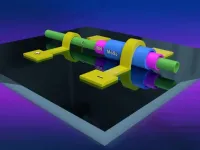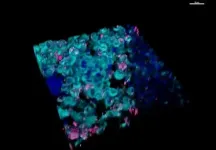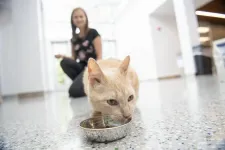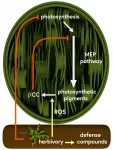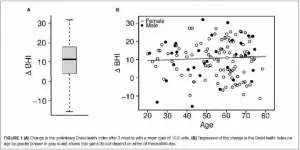(Press-News.org) The recent synthesis of one-dimensional van der Waals heterostructures, a type of heterostructure made by layering two-dimensional materials that are one atom thick, may lead to new, miniaturized electronics that are currently not possible, according to a team of Penn State and University of Tokyo researchers.
Engineers commonly produce heterostructures to achieve new device properties that are not available in a single material. A van der Waals heterostructure is one made of 2D materials that are stacked directly on top of each other like Lego-blocks or a sandwich. The van der Waals force, which is an attractive force between uncharged molecules or atoms, holds the materials together.
According to Slava V. Rotkin, Penn State Frontier Professor of Engineering Science and Mechanics, the one-dimensional van der Waals heterostructure produced by the researchers is different from the van der Waals heterostructures engineers have produced thus far.
"It looks like a stack of 2D-layered materials that are rolled up in a perfect cylinder," Rotkin said. "In other words, if you roll up a sandwich, you keep all the good stuff in it where it should be and not moving around, but in this case you also make it a thin cylinder, very compact like a hot-dog or a long sushi roll. In this way, the 2D-materials still contact each other in a desired vertical heterostructure sequence while one needs not to worry about their lateral edges, all rolled up, which is a big deal for making super-small devices."
The team's research, published in ACS Nano, suggests that all 2D materials could be rolled into these one-dimensional heterostructure cylinders, known as hetero-nanotubes. The University of Tokyo researchers recently fabricated electrodes on a hetero-nanotube and demonstrated that it can work as an extremely small diode with high performance despite its size.
"Diodes are a major type of device used in optoelectronics -- they are in the core of photodetectors, solar cells, light emitting devices, etc.," Rotkin said. "In electronics, diodes are used in several specialized circuits; although the main element of electronics is a transistor, two diodes, connected back-to-back, may serve as a switch, too."
This opens a potential new class of materials for miniaturized electronics.
"It brings device technology of 2D materials to a new level, potentially enabling a new generation of both electronic and optoelectronic devices," Rotkin said.
Rotkin's contribution to the project was to solve a particularly challenging task, which was ensuring that they were able to make the one-dimensional van der Waals heterostructure cylinder have all the required material layers.
"Using the sandwich analogy again, we needed to know whether we had a shell of 'roast beef' along the entire length of a cylindrical sandwich or if there were regions where we have only 'bread' and 'lettuce' shells," Rotkin said. "Absence of a middle insulating layer would mean we failed in device synthesis. My method did explicitly show the middle shells were all there along the entire length of the device."
In regular, flat van der Waals heterostructures, confirming existence or absence of some layers can be done easily because they are flat and have a large area. This means a researcher can use various type microscopies to collect a lot of signal from the large, flat areas, so they are easily visible. When researchers roll them up, like in the case of a one-dimensional van der Waals heterostructure, it becomes a very thin wire-like cylinder that is hard to characterize because it gives off little signal and becomes practically invisible. In addition, in order to prove the existence of insulating layer in the semiconductor-insulator-semiconductor junction of the diode, one needs to resolve not just the outer shell of the hetero-nanotube but the middle one, which is completely shadowed by the outer shells of a molybdenum sulfide semiconductor.
To solve this, Rotkin used a scattering Scanning Near-field Optical Microscope that is part of the Material Research Institute's 2D Crystal Consortium, which can "see" the objects of nanoscale size and determine their materials optical properties. He also developed a special method of analysis of the data known as hyperspectral optical imaging with nanometer resolution, which can distinguish different materials and, thus, test the structure of the one-dimensional diode along its entire length.
According to Rotkin, this is the first demonstration of optical resolution of a hexagonal boron nitride (hBN) shell as a part of a hetero-nanotube. Much larger pure hBN nanotubes, consisting of many shells of hBN with no other types of material, were studied in the past with a similar microscope.
"However, imaging of those materials is quite different from what I have done before," Rotkin said. "The beneficial result is in the demonstration of our ability to measure the optical spectrum from the object, which is an inner shell of a wire that is just two nanometers thick. It's comparable to the difference between being able to see a wooden log and being able to recognize a graphite stick inside the pencil through the pencil walls."
Rotkin plans to expand his research to extend hyperspectral imaging to better resolve other materials, such as glass, various 2D materials, and protein tubules and viruses.
"It is a novel technique that will lead to, hopefully, future discoveries happening," Rotkin said.
INFORMATION:
Along with Rotkin, other authors of the paper include Ya Feng, Henan Li, Taiki Inoue, Shohei Chiashi, Rong Xiang and Shigeo Maruyama, from the University of Tokyo.
The research was funded in part by the Center for Nanoscale Science, which is Penn State's National Science Foundation Materials Research Science and Engineering Center, and by the Japan Ministry of Education, Culture, Sports, Science and Technology.
Intervention research focusing on patients with multiple, simultaneous chronic illnesses is a priority for health organizations such as the National Institutes of Health and Canadian Institutes of Health Research. This is important as physicians seek to better understand how one disease may influence the course of another coexisting one, and how to best care for patients who are battling multiple health issues. Researchers conducted a controlled trial in patients 18 to 80 years with three or more chronic conditions. They collected quantitative data and conducted in-depth interviews with patients, family members and health care providers, then measured the ...
Cooperation is generally a good thing -- working together to reach a goal.
But in the case of cancer, it can be detrimental. University of Cincinnati researchers have discovered that cooperation between two key genes drive cancer growth, spread and treatment resistance in one particularly aggressive type of breast cancer.
The good news is, though, with this knowledge, they can continue to aim their targeted treatments at these genes, singularly and together, to stop breast cancer in its tracks.
This study is published in the March 9 online edition of the journal Cell Reports.
"According to the American Cancer Society's estimate, over 280,000 new cases of invasive breast cancer will be diagnosed in women in 2021," explains Xiaoting Zhang, PhD, professor and Thomas Boat Endowed Chair ...
Some of Princeton's leading cancer researchers were startled to discover that what they thought was a straightforward investigation into how cancer spreads through the body -- metastasis -- turned up evidence of liquid-liquid phase separations: the new field of biology research that investigates how liquid blobs of living materials merge into each other, similar to the movements seen in a lava lamp or in liquid mercury.
"We believe this is the first time that phase separation has been implicated in cancer metastasis," said Yibin Kang, the Warner-Lambert/Parke-Davis Professor of Molecular Biology. He is the ...
Broad political, economic, and social factors influence disciplinary punishment. In particular, over the last half century, such considerations have shaped jurisdictions' use of the death penalty, which has declined considerably since the 1990s. A new study examined the factors associated with use of the death penalty at the county level to provide a fuller picture of what issues influence court outcomes. The study concludes that partisan politics, religious fundamentalism, and economic threat influenced local decisions about the death penalty. The study also found that the size of the African American population, which ...
CHAPEL HILL, NC -- In a viewpoint perspective published in JAMA on March 9, 2021, a University of North Carolina Lineberger Comprehensive Cancer Center researcher and two other experts endorsed the Center for Medicare & Medicaid Services' (CMS) requirement for a patient and their doctor to engage in a shared discussion of benefits and harms before proceeding with a low-dose spiral computed tomography (LDCT) scan as a method for preventing lung cancer death. An accompanying evidence report detailed the benefits and harms from screening, suggesting that shared decision-making between a patient ...
URBANA, Ill. - If you haven't been the parent or caregiver of an infant in recent years, you'd be forgiven for missing the human milk oligosaccharide trend in infant formulas. These complex carbohydrate supplements mimic human breast milk and act like prebiotics, boosting beneficial microbes in babies' guts.
Milk oligosaccharides aren't just for humans, though; all mammals make them. And new University of Illinois research suggests milk oligosaccharides may be beneficial for cats and dogs when added to pet diets.
But before testing the compounds, scientists had to find them.
"When we first looked into this, there had only been one study on milk oligosaccharides in dogs, and none in domestic cats. The closest were really small studies on a single lion and a single ...
In a new study in PNAS, an international team of researchers including scientists from the Max Planck Institute for Chemical Ecology has shown that Arabidopsis thaliana plants produce beta-cyclocitral when attacked by herbivores and that this volatile signal inhibits the methylerythritol 4-phosphate (MEP) pathway. The MEP pathway is instrumental in plant growth processes, such as the production of pigments for photosynthesis. In addition to down-regulating the MEP pathway, beta-cyclocitral also increases plant defenses against herbivores. Since the MEP pathway is only found in plants and microorganisms, but not animals, knowledge of a signal molecule like beta-cyclocitral opens up new possibilities for the development ...
Brazilian researchers who study a native venomous fish have confirmed a route to drug development for the treatment of chronic inflammatory diseases such as multiple sclerosis and asthma.
The venomous toadfish Thalassophryne nattereri contains a peptide (TnP) with anti-inflammatory and anti-allergic potential. Confirmation of this potential has now come via the zebrafish Danio rerio, a popular aquarium species native to South Asia that shares 70% of its genome with humans and is widely used as a model for in vivo trials in drug development.
The researchers tested TnP in D. rerio to measure its toxicity. In a little over a year, their research showed that the peptide is safe. It did not cause cardiac dysfunction or neurological problems in the toxicity tests ...
Health care systems could save lives and minimize losses by optimizing resource allocation and implementing mitigation strategies, according to two new studies. Colorado State University researchers explored how our health care systems might perform under multiple disasters and multiple waves of COVID-19, and how we can keep them functioning when we need them most.
In the first study, published in Nature Communications, Civil and Environmental Engineering Ph.D. student Emad Hassan and Associate Professor Hussam Mahmoud investigated the compound effects of pandemics and natural disasters on health care systems. They combined wildfire ...
DALLAS (March 9, 2021) - Better brain health and performance for humankind is one step closer to reality with the successful trial of the groundbreaking BrainHealth Project. A cross-disciplinary team with the Center for BrainHealth® at The University of Texas at Dallas unveiled an easy-to-use online platform that delivers a novel, science-backed approach to measuring, improving and tracking one's own brain fitness.
A key innovation of the Project centers on the BrainHealth Index™ (BHI), which is based on a multidimensional definition of brain health and its upward potential. The BHI is a composite derived from a series of best-in-class assessments that explore ...
